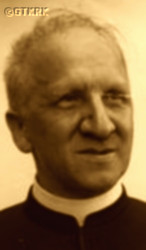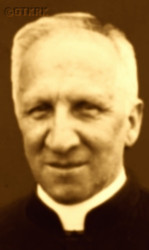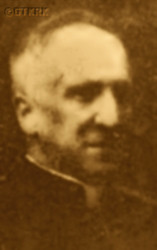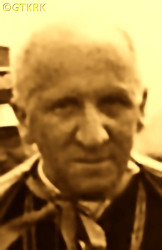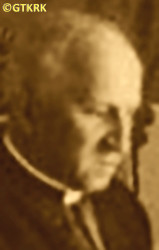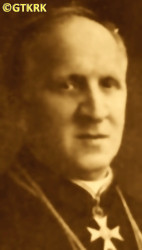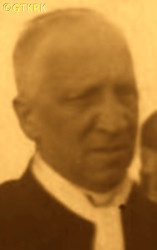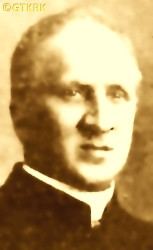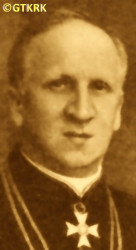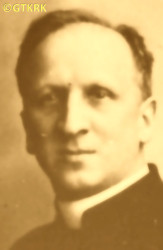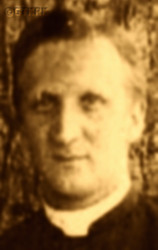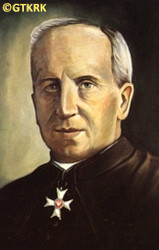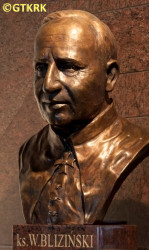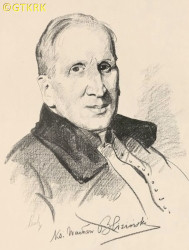Roman Catholic
St Sigismund parish
05-507 Słomczyn
85 Wiślana Str.
Konstancin deanery
Warsaw archdiocese, Poland
full list:
displayClick to display full list

searchClick to search full list by categories
wyświetlKliknij by wyświetlić pełną listę po polsku

szukajKliknij by przeszukać listę wg kategorii po polsku

Martyrology of the clergy — Poland
XX century (1914 – 1989)
personal data
surname
BLIZIŃSKI
forename(s)
Vaclav (pl. Wacław)
function
diocesan priest
creed
Latin (Roman Catholic) Church RCmore on
en.wikipedia.org
[access: 2014.09.21]
diocese / province
Włocławek diocesemore on
en.wikipedia.org
[access: 2013.05.19]
Włocławek i.e. Kalisz diocesemore on
pl.wikipedia.org
[access: 2019.10.13]
honorary titles
pontifical prelatemore on
en.wikipedia.org
[access: 2014.11.14]
(1934)
Prelate‐curator (Lat. praelati‐custos)more on
en.wikipedia.org
[access: 2015.09.30]
(1926 – c. 1939, Assumption of the Blessed Virgin Mary RC collegiate church, Kalisztoday: Kalisz city pov., Greater Poland voiv., Poland
more on
en.wikipedia.org
[access: 2020.12.16])
Minor Canonmore on
en.wikipedia.org
[access: 2014.11.14]
(1922 – , Assumption of the Blessed Virgin Mary RC collegiate church, Kalisztoday: Kalisz city pov., Greater Poland voiv., Poland
more on
en.wikipedia.org
[access: 2020.12.16])
honorary canonmore on
en.wikipedia.org
[access: 2014.11.14]
(1913, Assumption of the Blessed Virgin Mary RC collegiate church, Kalisztoday: Kalisz city pov., Greater Poland voiv., Poland
more on
en.wikipedia.org
[access: 2020.12.16])
„Polonia Restituta” Cross — 2nd Class, Commander's with Starmore on
en.wikipedia.org
[access: 2019.04.16]
(12.06.1937)
Gold „Cross of Merit”more on
en.wikipedia.org
[access: 2019.04.16]
(06.08.1936)
The late Erasmus and Anne Jerzmanowski Award of the Polish Academy of Learning PAUmore on
pl.wikipedia.org
[access: 2025.08.19]
(1935)
„Polonia Restituta” Cross — 3rd Class, Commander'smore on
en.wikipedia.org
[access: 2019.04.16]
(02.05.1923)
date and place
of death
17.10.1944

Częstochowatoday: Częstochowa city pov., Silesia voiv., Poland
more on
en.wikipedia.org
[access: 2021.12.18]
alt. dates and places
of death
21.10.1944
details of death
During secondary education studies in a gymnasium relegated from school for promoting Polish patriotic attitudes.
After rebirth of Poland in 11.1918, during Polish–Russian war of 1920, member of State Defence Council.
After German and Russian invasion of Poland in 09.1939 and start of the World War II, after start of German occupation — his parish found itself in Germ Reichsgau Wartheland (Eng. Wartha German Province), Greater Poland region incorporated into Germany in 1939 — forced to leave his parish for his name was on the one of the so‐called Germ. Sonderfahndungsliste (Eng. Special Wanted List), i.e. a proscription list of names of „enemies of the Reich”, prepared before the German aggression, or on some other proscription list, drawn up ad hoc list of Poles to be arrested and „eliminated” by Germans.
Crossed over to Germ. Generalgouvernement (Eng. General Governorate) and went into hiding in Warsaw.
After Warsaw Uprising went to Częstochowa and there perished.
cause of death
disease
perpetrators
Germans
sites and events
Warsaw UprisingClick to display the description, GeneralgouvernementClick to display the description, 02‐03.1940 arrests (Warthegau)Click to display the description, 26.08.1940 arrests (Warthegau)Click to display the description, Reichsgau WarthelandClick to display the description, Ribbentrop‐MolotovClick to display the description, Pius XI's encyclicalsClick to display the description, Polish‐Russian war of 1919‐1921Click to display the description
date and place
of birth
28.07.1870

Warsawtoday: Warsaw city pov., Masovia voiv., Poland
more on
en.wikipedia.org
[access: 2021.10.09]
presbyter (holy orders)
ordination
26.06.1892

positions held
1900 – c. 1941
parish priest — Liskówtoday: Lisków gm., Kalisz pov., Greater Poland voiv., Poland
more on
en.wikipedia.org
[access: 2020.11.01] ⋄ All the Saints RC parish ⋄ Turek / Kożminek / Kalisz‐southdeanery names/seats
today: Greater Poland voiv., Poland RC deanery
1938 – 1939
senator — Senate of the 5th Term of the Second Polish Republic
1926 – c. 1939
Prelate‐curator (Lat. praelati‐custos) — Kalisztoday: Kalisz city pov., Greater Poland voiv., Poland
more on
en.wikipedia.org
[access: 2020.12.16] ⋄ Collegiate Chapter ⋄ Assumption of the Blessed Virgin Mary RC collegiate church
1922 – 1926
Minor Canon — Kalisztoday: Kalisz city pov., Greater Poland voiv., Poland
more on
en.wikipedia.org
[access: 2020.12.16] ⋄ Collegiate Chapter ⋄ Assumption of the Blessed Virgin Mary RC collegiate church
1919 – 1922
parliamentary deputy — Seym i.e. Parliament (Legislative), Second Polish Republic — on behalf of the Polish People's Union, founded and managed by him
1894 – 1900
vicar — Włocławektoday: Włocławek city pov., Kuyavia‐Pomerania voiv., Poland
more on
en.wikipedia.org
[access: 2021.12.18] ⋄ Assumption of the Blessed Virgin Mary RC cathedral church
1892 – 1894
vicar — Cieszęcintoday: Wieruszów gm., Wieruszów pov., Łódź voiv., Poland
more on
en.wikipedia.org
[access: 2020.12.11] ⋄ St Adalbert the Bishop and Martyr RC parish ⋄ Wieluńtoday: Wieluń gm., Wieluń pov., Łódź voiv., Poland
more on
en.wikipedia.org
[access: 2021.07.18] RC deanery
1892
vicar — Zagórówtoday: Zagórów gm., Słupca pov., Greater Poland voiv., Poland
more on
en.wikipedia.org
[access: 2020.11.01] ⋄ St Peter and St Paul the Apostles RC parish ⋄ Słupcatoday: Słupca gm., Słupca pov., Greater Poland voiv., Poland
more on
en.wikipedia.org
[access: 2021.12.18] RC deanery
1887 – 1892
student — Włocławektoday: Włocławek city pov., Kuyavia‐Pomerania voiv., Poland
more on
en.wikipedia.org
[access: 2021.12.18] ⋄ philosophy and theology, Theological Seminary
founder — cooperative, cultural and educational institutions
activist — social
people's politician
co‐operative member
others related
in death
BRZEZIŃSKIClick to display biography Alexander
sites and events
descriptions
Warsaw Uprising: Lasted from 01.08.1944 till 03.10.1944. Was an attempt to liberate Polish capital from occupying Germans by the Polish Clandestine State — a unique in the history of the world political structure on the territories occupied by the Germans, effectively governing clandestinely in Poland — and by fighting on its behalf underground military units, mainly of Home Army (former Armed Struggle Association ZWZ) and National Armed Forced (NSZ). At the same time Russians stopped on purpose the offensive on all front, halted on the other bank of Vistula river and watched calmly the annihilation of the city, refusing even the mid‐landing rights to the Allied planes carrying weapons and supplies to the insurgents from Italy. During the Uprising Germans murdered approx. 200,000 Poles, mainly civilians. Approx. 200 priests and nuns died in fighting or were murdered by the Germans, many in mass executions. (more on: en.wikipedia.orgClick to attempt to display webpage
[access: 2013.08.17])
Generalgouvernement: After the Polish defeat in the 09.1939 campaign, which was the result of the Ribbentrop‐Molotov Pact and constituted the first stage of World War II, and the beginning of German occupation in part of Poland (in the other, eastern part of Poland, the Russian occupation began), the Germans divided the occupied Polish territory into five main regions. In two of them new German provinces were created, two other were incorporated into other provinces. However, the fifth part was treated separately, and in a political sense it was supposed to recreate the German idea from 1915 (during World War I, after the defeat of the Russians in the Battle of Gorlice in 05.1915) of creating a Polish enclave within Germany. Illegal in the sense of international law, i.e. Hague Convention, and public law, managed by the Germans according to separate laws — especially established for the Polish Germ. Untermenschen (Eng. subhumans) — till the Russian offensive in 1945 it constituted part of the Germ. Großdeutschland (Eng. Greater Germany). Till 31.07.1940 formally called Germ. Generalgouvernement für die besetzten polnischen Gebiete (Eng. General Government for the occupied Polish lands) — later simply Germ. Generalgouvernement (Eng. General Governorate), as in the years 1915‐1918. From 07.1941, i.e. after the German attack on 22.06.1941 against the erstwhile ally, the Russians, it also included the Galicia district, i.e. the Polish pre‐war south‐eastern voivodeships. A special criminal law was enacted and applied to Poles and Jews, allowing for the arbitrary administration of the death penalty regardless of the age of the „perpetrator”, and sanctioning the use of collective responsibility. After the end of the military conflict of the World War UU, the government of the Germ. Generalgouvernement was recognized as a criminal organization, and its leader, governor Hans Frank, guilty of war crimes and crimes against humanity and executed. (more on: en.wikipedia.orgClick to attempt to display webpage
[access: 2024.12.13])
02‐03.1940 arrests (Warthegau): First large wave of arrests of Polish Catholic clergy from German occupied Greater Poland region, transformed in to German province Germ. Reichsgau Wartheland (Eng. Greater Poland Reichs District), started in fact in 01.1940 but the largest numbers of priest were captured in 02‐03.1940. In accordance with a plan of „Ohne Gott, ohne Religion, ohne Priesters und Sakramenten” — „without God, without religion, without priest and sacrament” — being implemented by the Germ. Gauleiter (Eng. regional leader) of Germ. Reichsgau Wartheland, Artur Greiser, few hundred of Polish priests were interned in transit camps in Puszczykowo, IL Lubin in Lubiń, IL Bruckau in Bruczków, IL Görchen in Goruszki, IL Chludowo in Chludowo and KL Posen (Fort VII) concentration camp in Poznań, prior to transfer to concentration camps deep within Germany.
26.08.1940 arrests (Warthegau): As part of the Germ. „Ohne Gott, ohne Religion, ohne Priesters und Sakramenten” (Eng. „without God, without religion, without priest and sacrament”) policy, formulated by the Germ. Gauleiter (Eng. district head), Arthur Greiser, in the German province Germ. Reichsgau Wartheland (Eng. Wartheland Reichs District), organized by the Germans in the occupied part of Poland known as Greater Poland, hundreds of Polish priests were arrested on this day. Herded, together with priests arrested previously and held in IL Lond internment camp in Ląd on Warta river camp, among others, in DL Scheglin transit camp in Szczeglin n. Mogilno. Three days later all were transferred to KL Sachsenhausen concentration camp.
Reichsgau Wartheland: After the Polish defeat in the 09.1939 campaign, which was the result of the Ribbentrop‐Molotov Pact and constituted the first stage of World War II, and the beginning of German occupation in part of Poland (in the other, eastern part of Poland, the Russian occupation began), the Germans divided the occupied Polish territory into five main regions (and a few smaller). The largest one was transformed into Germ. Generalgouvernement (Eng. General Governorate), intended exclusively for Poles and Jews and constituting part of the so‐called Germ. Großdeutschland (Eng. Greater Germany). Two were added to existing German provinces. From two other separate new provinces were created. Greater Poland region was one of them, incorporated into Germany on 08.10.1939, by decree of the German leader Adolf Hitler (formally came into force on 26.10.1939), and on 24.01.1940 transformed into the Germ. Reichsgau Wartheland (Eng. Wartheland Reich Province), in which the law of the German state was to apply. The main axis of the policy of the new province, the territory of which the Germans recognized as the Germ. „Ursprünglich Deutsche” (Eng. „natively German”), despite the fact that 90% of its inhabitants were Poles, was Germ. „Entpolonisierung” (Eng. „Depolonisation”), i.e. forced Germanization. C. 100,000 Poles were murdered as part of the Germ. „Intelligenzaktion”, i.e. extermination of Polish intelligentsia and ruling classes. C. 630,000 were forcibly resettled to the Germ. Generalgouvernement, and their place taken by the Germans brought from other areas occupied by Germany (e.g. the Baltic countries, Bessarabia, Bukovina, etc.). Poles were forced to sign the German nationality list, the Germ. Deutsche Volksliste DVL. As part of the policy of „Ohne Gott, ohne Religion, ohne Priesters und Sakramenten” (Eng. „No God, no religion, no priest or sacrament”) most Catholic priests were arrested and sent to concentration camps. All schools teaching in Polish, Polish libraries, theaters and museums were closed. Polish landed estates confiscated. To further reduce the number of the Polish population, Poles were sent to forced labor deep inside Germany, and the legal age of marriage for Poles was increased (25 for women, 28 for men). The German state office, Germ. Rasse‐ und Siedlungshauptamt (Eng. Main Office of Race and Settlement) RuSHA, under the majesty of German law, abducted several thousand children who met specific racial criteria from Polish families and subjected them to forced Germanization, handing them over to German families. After the end of hostilities of World War II, the overseer of this province, the Germ. Reichsstatthalter (Eng. Reich Governor) and the Germ. Gauleiter (Eng. district head) of the German National Socialist Party, Arthur Karl Greiser, was executed. (more on: en.wikipedia.orgClick to attempt to display webpage
[access: 2024.06.21])
Ribbentrop‐Molotov: Genocidal Russian‐German alliance pact between Russian leader Joseph Stalin and German leader Adolf Hitler signed on 23.08.1939 in Moscow by respective foreign ministers, Mr. Vyacheslav Molotov for Russia and Joachim von Ribbentrop for Germany. The pact sanctioned and was the direct cause of joint Russian and German invasion of Poland and the outbreak of the World War II in 09.1939. In a political sense, the pact was an attempt to restore the status quo ante before 1914, with one exception, namely the „commercial” exchange of the so‐called „Kingdom of Poland”, which in 1914 was part of the Russian Empire, fore Eastern Galicia (today's western Ukraine), in 1914 belonging to the Austro‐Hungarian Empire. Galicia, including Lviv, was to be taken over by the Russians, the „Kingdom of Poland” — under the name of the General Governorate — Germany. The resultant „war was one of the greatest calamities and dramas of humanity in history, for two atheistic and anti‐Christian ideologies — national and international socialism — rejected God and His fifth Decalogue commandment: Thou shall not kill!” (Abp Stanislav Gądecki, 01.09.2019). The decisions taken — backed up by the betrayal of the formal allies of Poland, France and Germany, which on 12.09.1939, at a joint conference in Abbeville, decided not to provide aid to attacked Poland and not to take military action against Germany (a clear breach of treaty obligations with Poland) — were on 28.09.1939 slightly altered and made more precise when a treaty on „German‐Russian boundaries and friendship” was agreed by the same murderous signatories. One of its findings was establishment of spheres of influence in Central and Eastern Europe and in consequence IV partition of Poland. In one of its secret annexes agreed, that: „the Signatories will not tolerate on its respective territories any Polish propaganda that affects the territory of the other Side. On their respective territories they will suppress all such propaganda and inform each other of the measures taken to accomplish it”. The agreements resulted in a series of meeting between two genocidal organization representing both sides — German Gestapo and Russian NKVD when coordination of efforts to exterminate Polish intelligentsia and Polish leading classes (in Germany called «Intelligenzaktion», in Russia took the form of Katyń massacres) where discussed. Resulted in deaths of hundreds of thousands of Polish intelligentsia, including thousands of priests presented here, and tens of millions of ordinary people,. The results of this Russian‐German pact lasted till 1989 and are still in evidence even today. (more on: en.wikipedia.orgClick to attempt to display webpage
[access: 2015.09.30])
Pius XI's encyclicals: Facing the creation of two totalitarian systems in Europe, which seemed to compete with each other, though there were more similarities than contradictions between them, Pope Pius XI issued in 03.1937 (within 5 days) two encyclicals. In the „Mit brennender Sorge” (Eng. „With Burning Concern”) published on 14.03.1938, condemned the national socialism prevailing in Germany. The Pope wrote: „Whoever, following the old Germanic‐pre‐Christian beliefs, puts various impersonal fate in the place of a personal God, denies the wisdom of God and Providence […], whoever exalts earthly values: race or nation, or state, or state system, representatives of state power or other fundamental values of human society, […] and makes them the highest standard of all values, including religious ones, and idolizes them, this one […] is far from true faith in God and from a worldview corresponding to such faith”. On 19.03.1937, published „Divini Redemptoris” (Eng. „Divine Redeemer”), in which criticized Russian communism, dialectical materialism and the class struggle theory. The Pope wrote: „Communism deprives man of freedom, and therefore the spiritual basis of all life norms. It deprives the human person of all his dignity and any moral support with which he could resist the onslaught of blind passions […] This is the new gospel that Bolshevik and godless communism preaches as a message of salvation and redemption of humanity”… Pius XI demanded that the established human law be subjected to the natural law of God , recommended the implementation of the ideal of a Christian state and society, and called on Catholics to resist. Two years later, National Socialist Germany and Communist Russia came together and started World War II. (more on: www.vatican.vaClick to attempt to display webpage
[access: 2023.05.28], www.vatican.vaClick to attempt to display webpage
[access: 2023.05.28])
Polish‐Russian war of 1919‐1921: War for independence of Poland and its borders. Poland regained independence in 1918 but had to fight for its borders with former imperial powers, in particular Russia. Russia planned to incite Bolshevik‐like revolutions in the Western Europe and thus invaded Poland. Russian invaders were defeated in 08.1920 in a battle called Warsaw battle („Vistula river miracle”, one of the 10 most important battles in history, according to some historians). Thanks to this victory Poland recaptured part of the lands lost during partitions of Poland in XVIII century, and Europe was saved from the genocidal Communism. (more on: en.wikipedia.orgClick to attempt to display webpage
[access: 2014.12.20])
sources
personal:
pl.wikipedia.orgClick to attempt to display webpage
[access: 2013.06.23], adonai.plClick to attempt to display webpage
[access: 2013.06.23], bs.sejm.gov.plClick to attempt to display webpage
[access: 2013.07.06]
original images:
audiovis.nac.gov.plClick to attempt to display webpage
[access: 2016.03.14], audiovis.nac.gov.plClick to attempt to display webpage
[access: 2016.03.14], pl.wikipedia.orgClick to attempt to display webpage
[access: 2016.03.14], mbc.cyfrowemazowsze.plClick to attempt to display webpage
[access: 2018.09.02], senat.edu.plClick to attempt to display webpage
[access: 2020.09.18], publicystyka.ngo.plClick to attempt to display webpage
[access: 2020.09.18], www.archiwum.kalisz.plClick to attempt to display webpage
[access: 2020.09.18], muzeawielkopolski.plClick to attempt to display webpage
[access: 2020.09.18], www.wbc.poznan.plClick to attempt to display webpage
[access: 2020.09.18], polona.plClick to attempt to display webpage
[access: 2021.12.19], kalisz.liszewski.infoClick to attempt to display webpage
[access: 2020.09.18], www.wbc.poznan.plClick to attempt to display webpage
[access: 2020.09.18], sieradz-praga.plClick to attempt to display webpage
[access: 2018.09.02], tpl-lukus.kepno.plClick to attempt to display webpage
[access: 2020.09.18], www.info.kalisz.plClick to attempt to display webpage
[access: 2020.09.18], kalisz.liszewski.infoClick to attempt to display webpage
[access: 2020.09.18], cyfrowe.mnw.art.plClick to attempt to display webpage
[access: 2020.09.18], www.senat.edu.plClick to attempt to display webpage
[access: 2014.10.31]
LETTER to CUSTODIAN/ADMINISTRATOR
If you have an Email client on your communicator/computer — such as Mozilla Thunderbird, Windows Mail or Microsoft Outlook, described at WikipediaPatrz:
en.wikipedia.org, among others — try the link below, please:
LETTER to CUSTODIAN/ADMINISTRATORClick and try to call your own Email client
If however you do not run such a client or the above link is not active please send an email to the Custodian/Administrator using your account — in your customary email/correspondence engine — at the following address:

giving the following as the subject:
MARTYROLOGY: BLIZIŃSKI Vaclav
To return to the biography press below:
 Click to return to biography
Click to return to biography








